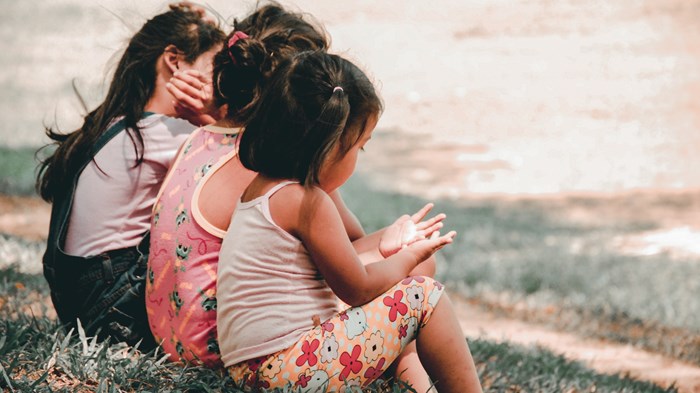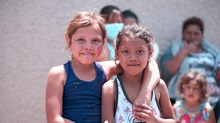Yes, Our Internalized Racism Affects Our Children. Here’s How to Handle It

Last week, my 4 year old son wanted to ask some older boys a question after his Taekwondo class, and those boys happened to be African-American. Jake loudly referred to them as the “brown boys”.
After hearing those words, I panicked. I was embarrassed, strangely fearful, and horrified as my son kept asking me if he could talk to the brown people. I apologetically smiled at the boys and hurried my children to the car. As I was buckling Jake into his seat and chastising him, he started to cry. When I asked him why he was crying, he said that he just wanted to ask them what color belt they had.
Upon hearing his explanation, I felt deep guilt and regret. My son was just curious, he was not referring to the children’s skin color in a derogatory or diminishing way. There was no judgment or mean-spiritedness in his statement, it was actually I that interpreted him using brown in a negative way when referring to their skin.
Internalized Racism Shows Up in Our Parenting
As we drove the rest of the way home in silence, my thoughts were racing. I am someone who champions racial reconciliation, cross cultural engagement and speak about them often. What was triggered inside of me that suddenly made me apologetic and shrink away at the mention of skin color?
I am the third child of Korean immigrants, and my hometown is almost completely White. My father was a doctor, and we were well-off, but I still ran home crying almost everyday because a classmate called me a racist slur or degraded my yellow skin. As the years passed, I began to internalize the racism I experienced and started hating myself. Internalized racism can be understood as “when people of color experience self-hatred because they’ve taken to heart the ideology that dubs them as inferior.”
My parents taught me at an early age to keep my head down and comply in cases of unfair or unjust treatment because they believed this was the only way we could survive in this inequitable country. Instead of facing the racism they were experiencing, they avoided and minimized it to protect themselves and their children. This modeled behavior that unintentionally created shameful feelings in me about who I was. I knew I did not want this to happen to my children today, so I identified some simple ways I could guide them in becoming race-conscious about themselves and others.
Teach our children to recognize and affirm racial differences as a love letter from a creative God
-
Whether you are White or BIPOC, we all have to confirm our belief in the intentionality in how God created us. This includes, but is not limited to race, skin color and ethnic background. Read Psalm 139: 4 with your children and affirm that God made them wonderfully and beautifully, but also ask them to de-center themselves and apply it to others, especially those that look different than them. One of our favorite books to read together is Eyes that Kiss in the Corner by Joanna Ho.
-
Celebrate your race and ethnic heritage by sharing traditions and customs with your children. Model how to share them with others with pride and confidence. Some great books to read to your children about race, ethnic heritage, and skin color are: Colorfull by Dorena Williamson, The Colors of Us by Karen Katz.
Be mindful about exposing our children to cultures and people of different ethnic backgrounds
-
Do this tactfully, but with intention. Avoid tokenism and wokeism by seeking out BIPOC neighbors with the intention of beginning a relationship with them. Do not treat them as a research project, but remember your goal is starting a friendship. Friends share their stories, meals, support each other, and live all facets of life together.
-
Seek out different public events, art exhibits, or festivals of different cultures to take your children to. One of the best ways to learn about another ethnic background is to experience their food, art, and music.
Ask about and listen to the racial experiences of those that are different from you, and honor their requests
-
Listen to the stories of your friends that have experienced racism and practice empathy. Their experiences are valid, even if it differs from your interpretation of events. Teach your children how to listen without adding their own viewpoint, unless asked to do so. Empathy Is Your Super Power is a wonderful book to read together.
-
Reach out to your friends of color who are parents. If they are overcome with racial stress and struggling with parenting their children, ask how you can help. Racial Stress and Self-care: Parent Tip Tool is a great resource you can point them to.
-
Teach your children the difference between cultural appropriation and appreciation.
My parents did the best they could to protect me in an environment that was often hostile to us solely because of our race. Although the world may not have changed much since then, my hope is that my children can see me now model pride in our “eyes that kiss in the corners and glow like warm tea” and our skin that looks like golden sand, and internalize those beliefs instead of racist ones. But more than that, I hope that they would know that every part of them was made intentionally by God, and that they would recognize the same in others. So, the next time my son refers to someone as cinnamon colored or rosy pink, I will affirm God’s creative workmanship by thanking him for drawing my attention to the profound beauty that is seen in our different colors.
Lora Kwan is a student in the M.A. at Wheaton College’s Humanitarian and Disaster Leadership (HDL) program, having previously earned an M.A. in Pastoral Care and Counseling from Talbot School of Theology. She cares deeply about racial reconciliation, and hopes to one day walk alongside human trafficked victims and refugees on the road from trauma to whole being restoration.
The Better Samaritan is a part of CT's
Blog Forum. Support the work of CT.
Subscribe and get one year free.
The views of the blogger do not necessarily reflect those of Christianity Today.






















